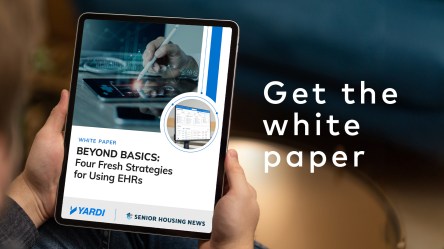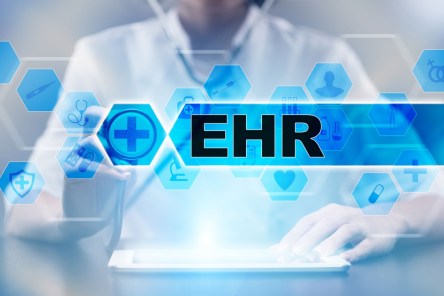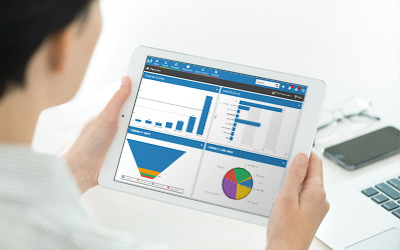Looking for new ways to use electronic health records (EHRs) in senior living? We’re pleased to sponsor a new white paper, Beyond Basics: Four Fresh Strategies for Using EHRs, which shows how senior living providers can get the most out of EHRs in all areas of operation. Keep reading for highlights, including insights from our director of healthcare solutions and EHR expert, Fil Southerland. Enhance resident satisfaction & operational efficiency A good EHR partner helps senior living operators deliver more efficient, higher quality care that is personalized for residents’ individual needs. The white paper categorizes four main areas of operations where they can apply EHRs in innovative ways: Preventing falls Enhancing dining programming Streamlining intake and transfer experiences Optimizing vital sign documentation Learn from industry experts To gain perspective on senior living operations with EHRs, Senior Housing News interviewed Southerland and representatives from four Yardi EHR partners: SafelyYou, eMenuCHOICE, Kno2 and DS smart. “With an operation that’s effectively using an EHR to proactively surface issues that may need attention, you can prevent expensive acute care encounters,” Southerland said. How does Yardi work with EHR partners? Yardi EHR is an electronic health record system for senior living providers. It offers comprehensive tools for medication management, clinical reporting and seamless information flow. It enhances resident care, operational efficiency and compliance, enabling caregivers to deliver personalized, high-quality care. Yardi EHR interfaces allow third-party partners and Yardi EHR users to exchange information seamlessly and securely. You can optimize care transitions and enable the secure flow of information to and from EHR. Questions about the Yardi Senior Living Suite? Reach out to our...
Investing in EHRs
Senior Living Study
It’s no secret that technology use is growing exponentially. Tech solutions are transforming the way various industries operate — including senior living — from EHRs to business intelligence tools. This ties into a recent Ziegler study, which examines 150 senior living organizations to learn how they’re using technology moving into 2023. With input gathered from CFOs, the study shares which solutions these organizations are implementing to meet today’s challenges. Read on for a quick snapshot of the study’s findings: Ziegler study reveals investments in EHRs The study — Ziegler CFO Hotline — gathers survey responses from CFOs across senior living. Ziegler presented various technologies relevant to the industry, and respondents were asked to identify which they’ve invested in over the last 12 months. Interestingly, the responses show a return to priorities of years prior to the COVID-19 pandemic. One of the top investments revealed was electronic health records — with 54% of respondents claiming they’ve invested in EHRs in the past year. When asked what they planned to invest in for the next 12 months, 31% of respondents pointed to EHRs as well. It’s no surprise given the major benefits EHRs bring to senior living organizations such as easing staff burden, empowering caregivers, mitigating risk, eliminating manual data-entry and more. Read the Ziegler study to gain further insights. Finding the EHR solution for you We know the world of technology is vast. Senior living organizations are faced with solutions left and right, and it can be challenging to determine how one differs from the next. That’s why we’ve created several resources that delve into our own solution, Yardi EHR, to show what makes it unique. At a glance, Yardi EHR is a full-service electronic health record solution that combines clinical intake processing, assessments, interoperability...
EHR Care Stream App
Available for Smartphones
For nurses and other care staff in senior living, having an efficient record-keeping system is crucial. And for staff members who work across multiple communities — or remotely — accessing an electronic health record system from a mobile device is largely beneficial. With the latest release of the Yardi EHR Care Stream app, users can now access the features from a smartphone — an advantageous step forward for senior care staff. This upgrade means the Care Stream app is compatible with both smartphones and tablet devices. In short, the upgrade allows nurses and care staff to perform order resolutions and execute point-of-care charting directly from a smartphone. This helps staff streamline workflows, save time and optimize care responsibilities. And with a user interface reformatted for smartphone use, the new and improved app supports all the same functionality as the tablet version. “With the flexibility to perform order resolutions and related tasks from a smartphone, senior care staff can complete their work more efficiently,” said Ray Elliott, vice president of senior living at Yardi. “The upgrade also helps staff members with limited access to tablet devices. Smartphone functionality allows more communities to utilize the app’s many benefits.” To download the Yardi EHR Care Stream app for smartphones, visit the Google Play Store or the App...
Promoting Health Sharing
With Senior EHR Tech
Electronic health records, or EHRs, have evolved into a necessity over the past few years in the senior living industry. In fact, a LeadingAge study in 2019 found that nearly 76% of the nation’s 200 largest nonprofit, multi-site senior living organizations use EHRs, as do the majority of single-campus senior living communities. EHRs enable care staff to chart and document residents’ medications and transitions between care settings in real time. Along with this efficiency, notes PharMerica, a pharmacy services provider for the senior living industry, senior community operators “are finding that EHR can help do things like boost occupancy and profitability. And vendors are finding easier to promote EHR benefits around greater resident engagement, streamlined workflow and reduced staff turnover.” Additional benefits of EHRs include facilitating Medicare and Medicaid reimbursements and ensuring compliance. Interoperability is crucial There’s yet another dimension to EHRs. Senior Housing News reports that some providers adopting EHRs “are actually going a step further to connect those EHRs to larger networks in the interest of electronically sharing information with doctors, hospitals or other clinicians.” Making such exchanges securely across multiple systems requires connection to a service provider for health information exchanges, or HIEs. “It’s only a matter of time before mounting state and federal pressure to connect EHRs to HIEs becomes too difficult for senior living providers to ignore,” the news source reports. Some in the industry are still playing catch-up. Clinical information is still often shared via fax, phone or printouts, opening the door to mistakes and omissions. And patients often receive paper medical records when they are discharged, creating additional opportunities for documentation errors and impeded care coordination. “The COVID-19 pandemic has amplified the importance of interoperability and the ease in which clinical information needs to be available to an entire healthcare community,” says Jon Elwell, CEO of Scottsdale, Ariz. interoperability provider Kno2. “We cannot rely on paper fax for this important task.” Creating seamless transitions Going forward, the need for interoperability among acute care, private practice, skilled nursing and other healthcare partners will spur the development additional for care transition and coordination. That means “seamless care transitions and sharing of critical patient information between the senior living community and the providers participating in their care, improving coordination and reducing administrative burden from a historically manual process,” Elwell says. Once implemented, this interoperability will spur “increased efficiency and quality outcomes, improved ability to avoid adverse events and timely access to information from your patients’ other providers,” according to the Minnesota Department of Health. “Creating shared care plans and following up on the execution of those plans to optimize outcomes, reduce length of stay, or eliminate unnecessary hospital admissions via HIE will be key,” adds Majd Alwan, senior vice president of technology and executive director of the LeadingAge Center for Aging Services Technologies, an advocate for technologies that improve the aging experience. Yardi’s contribution to EHR interoperability includes a partnership with Kno2®, whose Interoperability as a Service™ drives connectivity for health data networks. Interoperability as a Service’s integration with Yardi EHR lets Yardi clients electronically send and receive health data, ensuring safer clinical care transitions. Look to The Balance Sheet for more updates on the continuing evolution of EHR capabilities, which PharMerica says have the potential to “revolutionize the way seniors are treated and cared for in the years to come.” For more on Yardi’s electronic health record solution for senior living, visit the Yardi EHR product...
EHR Interfaces
Senior Living Interoperability
Yardi has a long history of providing interface solutions that enable its clients to exchange information with third-party vendors of solutions for applicant screening, online billing payments, renters insurance, service requests and many other business requests. That interoperability extends to senior housing community operators who wish to connect with ancillary operations solution providers. Interfaces allow third-party partners and Yardi EHR users to exchange information seamlessly and securely. Operators can utilize standard interfaces to connect senior living integration partners. Also, operators can optimize care transitions and enable the secure flow of information to and from EHR. Among Yardi’s interface partners for senior living is eMenuCHOICE, a St. Paul, Minn.-based dining management and point of sale application for senior living communities. Other providers that Yardi has welcomed as senior living interface collaborators include abxtracker, which specializes in antibiotic and infection tracking control solutions; Healthconnex, a leading provider of software used for infection prevention and control; and Kno2, which creates centralized accounts that enable efficient and HIPAA-compliant exchanges of resident documents. The list of Yardi senior living interfaces continues to grow. Created in some cases as a result of client requests, the added partnerships will enhance interoperability in such operations as vital signs and weight monitoring, nurse calls and...
Yardi Enhances EHR
Update on Upgrades
Yardi has been building Yardi EHR, a full service electronic health record solution for senior living, for the better part of a decade. Client feedback and ongoing development give rise to regular product enhancements. Here’s a sampling of recent upgrades. Clinical move-in Users can now execute a clinical move-in process that includes adding global contacts, allergies, diagnosis, orders from a library, and schedule assessments. This new feature allows a facility to perform a financial move-in prior to the resident physically arriving in the building or vice versa. Clinical staff can move a resident in and the billing staff can complete the financial move-in when they return. A new KPI shows a resident’s pending move-in status, allowing the facility to easily monitor resident move-in activities. Medication tracking Recent enhancements allow counting of controlled substances between shifts, check-in of medications delivered to the community and documentation of medications disposed of. Facilities can also update the quantity of medication on hand when new deliveries arrive. Digital care plan signatures New functionality enables digital signing of service plans. Five new KPIs monitor the signing status. Continuity of care document interface (CCDA) Facilities can now create, send and receive CCDA documentation using the KNO2 interface. The CCDA document sends and receives data elements in a standard format. Information exchanged includes advanced directives, allergies, adverse reactions, medications and social history. The CCDA user interface lets you search for documents by a date range or create a new document. Shower/housekeeping/laundry schedule A new report assists staff with weekly shower, laundry and housekeeping schedules. Filters allow for multiple schedules to be displayed and is viewable in a list or calendar view. The list view can also display task details. Simple wounds The wound module has been streamlined and enhanced for assisted living...
Hospitality to Healthcare
Senior Living Tech Shift
Senior housing providers are witnessing a major shift within the industry. Traditionally following a hospitality format, today’s senior living specialists now adapt pages from healthcare models. The pandemic prompted senior living staff to implement more on-premises care methodologies. The results are fewer in-person touch points, enhanced health tracking and preventative care. With these changes come new challenges. Bob Kramer is the co-founder of the National Investment Center for Seniors Housing and Care (NIC), a Yardi partner. Kramer shares his insights on the challenges faced by senior housing professionals as they shoulder more on-premises care for residents. Learn about the benefits of the NIC Actual Rates Initiative for senior housing market data. A transformation born from necessity In recent history, senior housing providers focused on the resident experience. Staff left health care in the capable hands of off-site experts. COVID-19, however, required staff to renegotiate the barrier between hospitality and health care. In addition to their existing responsibilities, housing providers initiated on-premises health care tasks. “[The pandemic is causing] what you might call the creative destruction of some of what has been the paradigm to senior housing and care,” Kramer explained during a panel interview. “The senior housing and care model that we don’t do health care, and that we ship out our residents for health care services, I just don’t think that model will survive.” He continued, “That doesn’t mean senior living providers need to abandon hospitality-driven models altogether. But it does likely mean they need to rethink how they coordinate care within their communities.” Reimagining doctor’s visits and communication “In just the past six months, older adults have learned to fear the hospital, the emergency room and the doctor’s office, as these are places now associated with a deadly pandemic,” Kramer said. With the help of site staff, residents have taken comfort in telehealth options. Housing professionals forged partnerships with health care providers to offer remote care. Through this alternative, seniors skip unnecessary transport to medical specialists. They receive assessments and basic care from the comfort and familiarity of their communities. Community staff members implement software to help manage residents’ chronic conditions and any changes in wellness. Routine maintenance that was once handled off-site now takes place within residents’ rooms. Emerging from the pandemic, it’s unlikely that telehealth services and community-centered care will fade from practice, suggests Kramer. Staff can rely on technology and data to make the new on-site care model more efficient and secure. Data and interoperability at the intersection of senior housing and health care Interoperability and data management are lingering concerns with senior living providers. The concern has only grown as more care takes place within communities instead of hospitals. An upcoming change in policy may provide the guidance and structure that senior living providers seek. The Interoperability and Patient Access final rule from the Centers for Medicare & Medicaid Services (CMS) requires all health plans to present their data as an application programming interface. Proposed to take effect by July 1, 2021, the policy gives developers insight into general health care data. They can then use that information to address interoperability issues in new technologies. The data can also highlight trends in resident behavior or assessments that allow staff to take proactive care measures. As with all things data, the more information uploaded, shared, and properly analyzed, the more accurate insights become. “The challenge is making sure they have the means to upload their observations that are then screened by an algorithm searching for red flags and are instantly shared with those responsible for the delivery and care for that individual,” Kramer said. While site staff will enter their observations, residents can be empowered to share their health data on their own. Kramer expects strong participation. He observes that many Boomers want to be proactive about their health. “I do think that this is the role of tech, in enabling Boomers to self-direct...
Medication Management...
The evolution of oversight
Every day, millions of Americans start their morning the same way: with a handful of prescription pills. In fact, nearly a third of all adults take five or more medications regularly. In senior living communities, the number is even higher with the average resident consuming a staggering 12-14 medications per day, thanks, in part, to a concept known as the prescribing cascade. This begins when a drug is prescribed, an adverse drug event (ADE) occurs, and the symptoms are misinterpreted as an entirely new medical condition, for which an additional medication is prescribed. With advancements in science and technology, doctors and their patients now have thousands of different drugs to choose from. The influx of medications available on the market has caused prescription drug use to explode, growing 85% over the last two decades. This trend is exacerbated by a massive number of aging baby boomers, many of whom will soon require care. How can caregivers in the senior living industry manage medications and mitigate risk in an increasingly drug-dependent world? One of the simplest strategies to implement is called the five rights: The Right Drug Prescription medications often have names that are easily mixed up. To minimize confusion between those that look or sound alike, the FDA reviews about 300 drug names a year before they hit the market—and about one-third of the names drug companies propose are rejected. For this reason, it’s critical to double or triple check the order with the label on the prescription packaging. The Right Route There are more than fifteen ways to administer medication, so never make assumptions. A pill, for instance, can be swallowed, crushed or held inside the cheek. Check that the medication can be given as ordered. If it’s an injection, check to see if it should be administered intravenously or intramuscularly. And if the medication lacks specific instructions, ask. The Right Dose Improper dosing is the number one contributing factor to fatal drug errors. When people...
Empowering Nurses
SRI Uses Yardi EHR + eMAR
Dennis McCarthy, chief information officer at Florida’s SRI Management, knows that nurses are critical to providing quality care for residents. Keeping clinical staff happy means making sure they’ve got the tools they need to do their jobs as easily and efficiently as possible. That starts with ensuring they have access to the most accurate, up-to-date patient health records. “Satisfying nurses is the number one thing. You don’t want them on a separate system; once you have people on two systems you have all sorts of issues—nurses are trying to figure out which record is current and things like that. Integration to the core software is critical,” McCarthy explained. That’s why SRI, already successfully using several modules in the Yardi Senior Living Suite, adopted Yardi EHR and eMAR last July. “We just had nurses watch it in action,” said McCarthy. Once the staff got their first look, they were hooked. The team began using EHR right away to record resident incidents. Documentation was simple and everything that was logged was immediately appended to residents’ files in the database and kept as part of their permanent record. But the best part was that all the information was readily available after the fact, said Casey Polk, chief nurse and director of resident services. She finds that feature indispensable. “At my fingertips in the Yardi platform, I have easy access to what nurses wrote and charted about each incident and how it was handled. I can quickly pull up the chart and read the notes and have all the information on hand. And I love that the software also has reports on resident activity, new orders and missed medications. It allows me to follow up with my staff based on what has or hasn’t been charted that week,”...
Senior Living Trends
Great Expectations for 2017
As the year begins and a new administration takes office, senior housing providers are gearing up for change. While a certain amount of anxiety is to be expected, according to George Yedinak from Senior Housing News, many of the developments that will take place over the next twelve months merely build upon preexisting circumstances. “While operators, owners, and others will be reacting to possibly dramatic changes,” he writes, “some senior living issues that have been top of mind for years show no signs of abating.” Occupancy and Oversupply According to the National Investment Center for Seniors Housing and Care, nursing home occupancy remained flat through the end of 2016 even as the number of units in development continued to rise. That trend will likely continue across all types of senior care well into 2017. With the pool of potential residents unable to match supply, even well-established providers may find themselves “protecting their turf.” “New supply could affect everything from rents to marketing budgets and wages,” writes Yedinak. “Developers looking to build, or buyers on the hunt for good opportunities, will feel even more pressure to judge the supply-demand forces in a given market.” Although consumer purchasing power has steadily increased over the last year, increasing pressure from new supply will undermine rent escalation. As a result, says Yedinak, any rent increases in competitive markets will likely hover around two to three percent rather than the standard three to four percent. “Getting rents right will be even more of a balancing act than usual in 2017,” he warns, adding that operators should be aware of the “steady drumbeat within the industry to cease discounting altogether and increase pricing transparency, to meet consumer expectations.” Staffing Shortfalls For the last few years, workforce woes have plagued senior...
Disruptive Change
Electronic Health Records
Adoption of electronic health records in assisted living is a disruptive change worth implementing declares Senior Housing Business magazine. As Eric Taub points out in a recent article for Senior Business News, assisted living communities have dragged their feet for too long, many still stubbornly relying on paper notes and other “low-fi.” record keeping. While these facilities have been able to limp along so far, Taub argues that “going high-tech is no longer an option. It’s not a case of simply providing a perk for residents but rather becoming a necessity to stay financially viable.” “That’s because the model of the assisted living industry is changing,” he writes, “Moving from a social framework with a medical conscience to a medical model with a social conscience.” The first step, according to Taub, involves adopting EHR and EMR systems, but implementation should follow a thorough understanding of the processes, procedures and costs. “While EMRs may be an obvious solution to more accurately tracking resident health and coordinating care with other providers, the implementation of such a systems is not,” explains Taub. “Assisted living communities face significant obstacles in switching their pen-and-paper based medical records to an electronic version.” “Change is hard,” admits Taub, “especially one as fundamental as introducing technology to a formerly analog world.” Tom McDermott, Vice President of Sales for Yardi Senior Living agrees, telling Taub that for many senior living communities, technology is not a priority. “Most people would rather get a root canal than change software,” he says, pointing out that facility managers and administrators often juggle many duties and struggle to prioritize their strategies. Nevertheless, Taub believes resistance is futile – soon assisted living communities will have no choice. “Baby boomers will demand it,” Life Care Services’ EMR director for Life Care Services Susan Adams, tells Taub. “I...
Vantage Point
Selects Yardi Senior Suite
Vantage Point Retirement Living (Vantage Point) has selected the Yardi Senior Living Suite, including flagship components Yardi Voyager® Senior Housing and Yardi EHR™, as its completely integrated platform for marketing, finance, community operations, and resident care management. Rita Stevens, vice president of operations for the southeastern Pennsylvania-based senior living provider, described the features and benefits offered by Yardi which made the software system attractive to Vantage Point. “The ability to have real-time information shared between corporate offices and communities is incredibly valuable. But even more than that, getting our community staff, outside physicians, and other care specialists connected is critical to serving our residents. For example, we have found that the Yardi Senior Living Suite makes information secure and available for up-to-date reporting on our residents’ medical information such as lab results and prescribed medications. This centralization of live data enables us to create the best possible outcomes for our residents, each and every time,” said Stevens. The Yardi Senior Living Suite replaces multiple software systems across Vantage Point’s marketing, accounting, and health care business units. “Our former software did not ‘talk’ to each other, which meant information did not flow very well between departments and that we often saw instances of duplicated data processing. One of our primary goals in reviewing new software was to have information tracking easily from a prospect’s initial point of contact at our communities, through their move-in date, and then throughout their residency with us. We found that Yardi provided the most streamlined processes to enable us to reach that goal, particularly with the capabilities Yardi offers for electronic health records and medication administration,” said Stevens. “Vantage Point is a great example of how senior living providers can consolidate their investment in technology and reap the rewards of...
Yardi Senior CRM
Sales, Marketing, Mobility
Yardi announced today the release of its new Yardi Senior CRM product, an advanced customer relationship management solution built into the Yardi Voyager® Senior Housing platform and integrated with all the Yardi Senior Living Suite™ products. “We matched the capabilities of a traditional CRM system with the workflows unique to senior living, and we did so within a complete business solution built on the latest mobile and Web-based technology available,” said Eric Kolber, vice president of senior living for Yardi “Yardi Senior CRM delivers powerful metrics to calculate return on marketing investment, enables insightful sales pipeline projections using real-time data, and facilitates accurate pricing proposals for prospective residents based on assessed healthcare recommendations,” explained Kolber. Data generated through Yardi Senior CRM flows freely throughout the Yardi Senior Living Suite. “The complete integration of our ERP, CRM, and EHR solutions streamlines workflows and improves data integrity. For example, when a prospect hits a certain point in the sales cycle, Senior CRM notifies nurses that a needs evaluation is required, and their resulting recommendations automatically flow through to subsequent pricing proposals. Information is easily shared between sales and clinical staff, and all relevant data carries forward to billing functions and accounting personnel. No interfaces are required, and no redundant data entry is needed. Staff are kept informed and alerted to actionable items in real time,” said Kolber. Yardi Senior CRM is a browser-based solution accessible from any desktop computer, laptop, tablet, or smartphone. “Senior CRM gives leasing agents mobile access to all of the tools they need to easily and effectively work with prospects and convert leads into sales,” added Kolber. Yardi Senior CRM is a component of the Yardi Senior Living Suite which includes Yardi Voyager Senior Housing for managing occupancy, accounting, and property management,...













